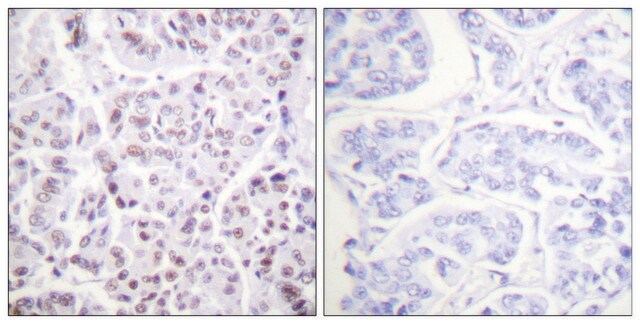17-658
ChIPAb+ Acetyl-Histone H3 (Lys9) Purified - ChIP Validated Antibody and Primer Set
from rabbit, purified by using Protein A
Synonym(s):
H3K9Ac, Histone H3 (acetyl K9)
About This Item
Recommended Products
biological source
rabbit
Quality Level
antibody form
purified immunoglobulin
clone
polyclonal
purified by
using Protein A
species reactivity
human, mouse
species reactivity (predicted by homology)
mammals
manufacturer/tradename
ChIPAb+
Upstate®
technique(s)
ChIP: suitable
immunocytochemistry: suitable
immunoprecipitation (IP): suitable
western blot: suitable
NCBI accession no.
UniProt accession no.
shipped in
dry ice
Gene Information
human ... H3F3B(3021)
General description
The ChIPAb+ Acetyl-Histone H3 (Lys9) set includes the anti-acetyl-histone H3 (Lys9) antibody, a negative control antibody (purified Rabbit IgG), and qPCR primers flanking an Sp1 binding site in the human p21 (WAF1/CIP1/CDKN1A) promoter, amplifying a 105 base pair PCR product. The acetyl-histone H3 (Lys9) and negative control antibodies are supplied in a scalable "per ChIP" reaction size and can be used to functionally validate the precipitation of acetyl-histone H3 (Lys9) associated chromatin.
Specificity
Immunogen
Application
Sonicated chromatin prepared from untreated or UV treated (50 J/m2, 6 hrs.) U2OS cells (3 X 106 cell equivalents per IP) was subjected to chromatin immunoprecipitation using 5 μg of either a normal rabbit IgG or Anti-Acetyl-Histone H3 (Lys9) antibody and the Magna ChIP A (Cat. #17-610) Kit. Successful immunoprecipitation of acetyl-histone H3 (Lys9) associated DNA fragments was verified by qPCR using control ChIP Primers p21 flanking the human p21(WAF1/CIP1/CDKN1A) promoter (Please see figures). Data is presented as fold enrichment of normalized percent input of each IP sample relative to input treated or untreated chromatin.
Please refer to the EZ-Magna A ChIP (Cat. #17-408) or EZ-ChIP (Cat. #17-371) protocol for experimental details.
Western Blot Analysis:
Acid-extracted proteins from normal HeLa cells (Lane 1) and HeLa cells treated with 5 mM sodium butyrate for 24 hours (Lane 2) were resolved by electrophoresis, transferred to PVDF membrane and probed with Anti-Acetyl Histone H3 (Lys9) (1 μg/mL). Proteins were visualized using a goat-anti rabbit secondary antibody conjugated to HRP and a chemiluminescence detection system (Please see figures).
Epigenetics & Nuclear Function
Chromatin Biology
Packaging
Quality
Sonicated chromatin prepared from UV treated (50 J/m2, 6 hrs.) U2OS cells (3 X 106 cell equivalents per IP) were subjected to chromatin immunoprecipitation using 5 μg of either a normal rabbit IgG or Anti-Acetyl-Histone H3 (Lys9) antibody and the Magna ChIP A (Cat. #17- 610) Kit. Successful immunoprecipitation of acetyl-histone H3 (Lys9) associated DNA fragments was verified by qPCR using control ChIP Primers p21 flanking the human p21(WAF1/CIP1/CDKN1A) promoter (Please see figures).
Please refer to the EZ-Magna A ChIP (Cat. #17-408) or EZ-ChIP (Cat. #17- 371) protocol for experimental details.
Target description
Physical form
Normal Rabbit IgG. One vial containing 125 ug purified Rabbit IgG in 125 uL storage buffer containing 0.05% sodium azide.
ChIP Primers p21. One vial containing 75 μL of 5 μM of each primer specific for a region of the human p21 (WAF1/CIP1/CDKN1A) promoter.
FOR: GTG GCT CTG ATT GGC TTT CTG
REV: CTG AAA ACA GGC AGC CCA AG
Storage and Stability
Analysis Note
Included negative control antibody purified rabbit IgG and control primers specific for human p21 (WAF1/CIP1/CDKN1A) promoter.
Legal Information
Disclaimer
Storage Class Code
12 - Non Combustible Liquids
Flash Point(F)
Not applicable
Flash Point(C)
Not applicable
Certificates of Analysis (COA)
Search for Certificates of Analysis (COA) by entering the products Lot/Batch Number. Lot and Batch Numbers can be found on a product’s label following the words ‘Lot’ or ‘Batch’.
Already Own This Product?
Find documentation for the products that you have recently purchased in the Document Library.
Our team of scientists has experience in all areas of research including Life Science, Material Science, Chemical Synthesis, Chromatography, Analytical and many others.
Contact Technical Service








